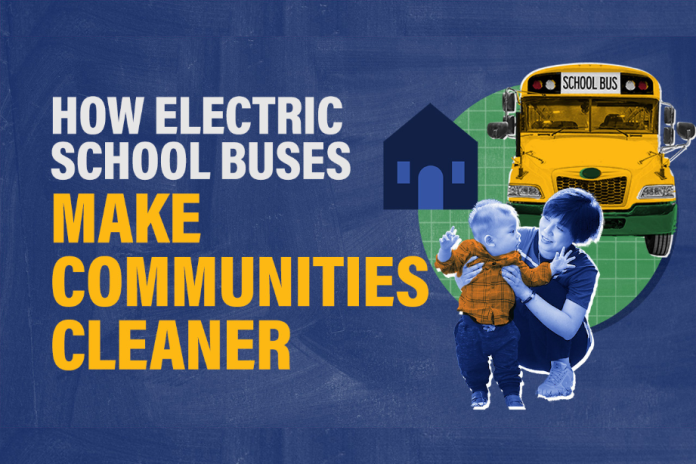Communities Need Better Air Quality
How can you help electric school buses improve air quality for communities with the worst air pollution?

Diesel fumes don’t just harm students. They harm entire communities by exposing drivers, teachers, mechanics and residents along routes or near depots to their pollutants—which contributes to an already inequitable distribution of pollution.
Due to the long-term impact of racist policies, 72% of the residents in counties with the worst air quality are people of color.* This poor air quality can lead to asthma, other respiratory illnesses and cancer.
How electric school buses can help
School bus electrification can remove one source of air pollution for these communities and pave the way for other electric vehicles (EV) and renewable energy investments.
Investing in electric school buses will contribute to a sector-wide tipping point for medium-and-heavy-duty EVs by increasing manufacturing capacity, improving charging infrastructure and decreasing prices. Electrifying the entire sector will have an even greater impact on air pollution, especially in the communities of color who are disproportionately concentrated near highways.
Centering equity in the electric school bus transition includes working against systemic underinvestment in certain schools and prioritizing electrification efforts in the neighborhoods with the highest levels of air pollution.
An equitable transition to electric school buses will prioritize the long-term needs of disproportionately-impacted communities by understanding their interests, delivering intentional benefits and being community-driven throughout the process.
How You Can Help
Students, parents and community members: Talk to your school board, superintendent or transportation department about the air quality benefits of school bus electrification.
- Look at this pitch deck for ideas on messaging.
- Visit our data dashboard to learn about your district’s fleet and start a conversation about electrification, especially if your buses are older than 13 years.
- Use EJScreen or the EPA Air Quality Index to see your area’s pollution levels, to make the case for investing in electric school buses.
Residents in high pollution areas: Ask your policymakers to adopt legislation that invests in your air quality such as the Advanced Clean Trucks (ACT) rule or electric school bus requirements paired with funding that prioritizes high pollution districts.
- Check out these resources for community advocates.
- Use EJScreen or the EPA Air Quality Index to see your area’s pollution levels, to make the case for investing in electric buses.
Drivers and mechanics: Talk to your transportation director about the dangers of diesel exhaust.
- Learn more about the dangers of diesel.
- Show them stories about drivers and mechanics benefiting from the transition to electric school buses.
Policymakers: Prioritize vehicle electrification funding in disproportionately-impacted communities through zero emissions heavy-duty vehicle and electric school bus programs.
- Adopt the Advanced Clean Trucks (ACT) rule to grow your state’s medium-and-heavy-duty EV fleet, including electric school buses.
- Look to provide funding and financing options for all school districts.
- Explore other states’ policy successes for ideas on what could work in your area.
School districts: Talk to your community and consider how your buses contribute to pollution for your workers, students and neighbors.
- Design routes or site charging infrastructure to benefit communities with the most pollution. Use tools like: EPA Air Quality Index, Census Data, or University of Richmond’s Redlining Tool to help with route selection.
- See if your project can promote investments in renewable energy or other electric medium- and heavy-duty fleet vehicles.
- Visit our data dashboard to learn about your district's fleet and start a conversation about electrification, especially if your buses are older than 13 years.
Where Can You Learn More
- The Alliance for Electric School Buses
- Mothers Out Front
- Moms Clean Air Force
- American Lung Association
- Equity Framework to Guide the Electric School Bus Initiative – WRI’s Electric School Bus Initiative
- How Students Can Take Action – WRI’s Electric School Bus Initiative
- Poison in the Air – ProPublica
- Indigenous People and Air Pollution in the United States – Moms Clean Air Force– Moms Clean Air Force
- Prioritizing Justice in New York State Climate Policy: Cleaner Air for Disadvantaged Communities? – Resources for the Future
*People of color defined in the cited study as Hispanic or non-Hispanic black, Asian, American Indian/Alaska Native, Native Hawaiian and Other Pacific Islander, or two or more races and based on 2021 county population estimates (U.S. Census)